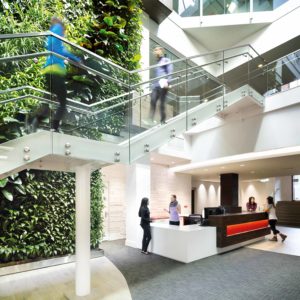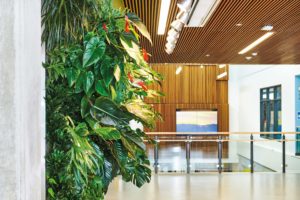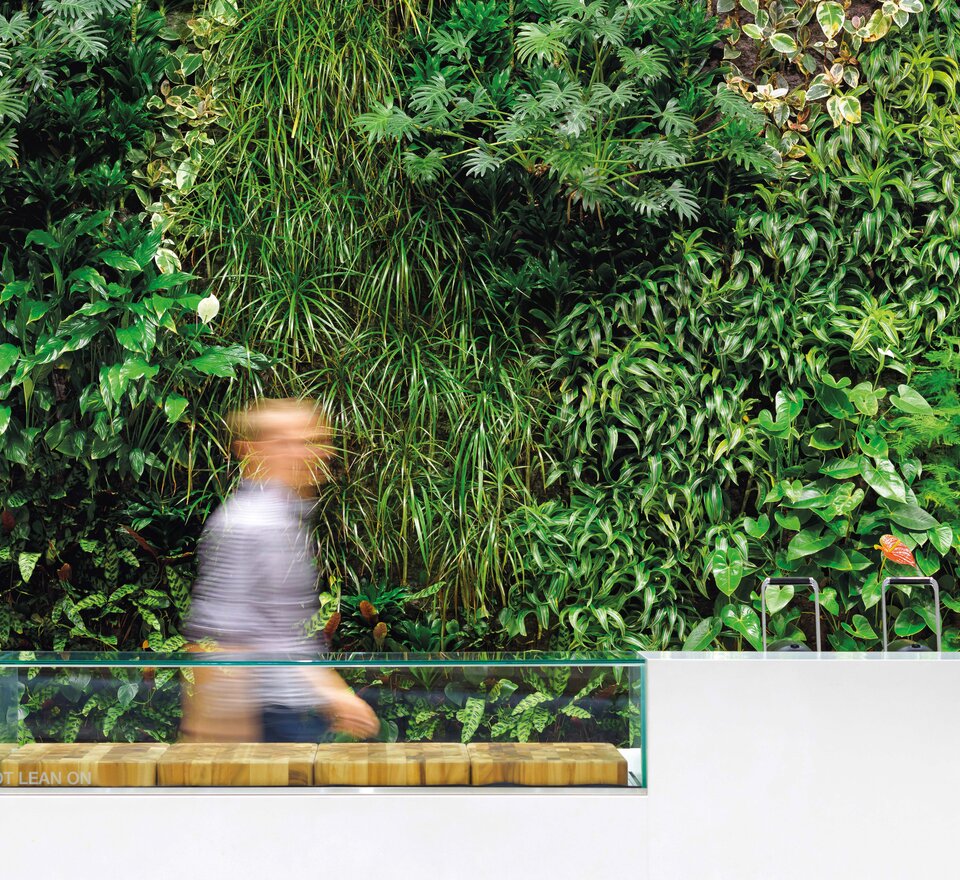In the past few years, offices have been growing cooler and smoother. But this time seems to be over now. Thanks to recent developments in longing for digitization and corona office culture more and more people are looking for green, natural materials and a stronger relation to mother nature. A declaration of love to Biophilic Design.
Steve Mitrione from the University of Minnesota observed that patients who could view a green hedge outside were noted for their higher level of alpha activity. In other words: it makes them feel relaxed. In contrast, patients who are fated to look at a concrete wall show an increase in beta activity. They feel stress.
Roger S. Ulrich, professor of architecture at the Centre for Healthcare Building Research at the Chalmers University of Technology in Gothenburg, found that patients with a view of the garden recover faster than those who have to look at a brick wall. This shortens their stay in hospital.

And Clare Cooper Marcus, professor emeritus of landscape architecture at the University of California in Berkeley, discovered that patients in a green environment need far less pain medication and on average leave the hospital a few days earlier than patients without a natural environment. Hospital architecture has been showing the impact of the scientific studies made in the 1990s and 2000s for some time now. The planning of hospitals would be inconceivable today without the guidelines of so called biophilic architecture; otherwise, their operation would be far more inefficient and therefore more expensive, because every unnecessarily occupied bed devours economic assets – in Austria a hospital bed currently costs 682 euros per day.
Green office.
The advantages of biophilic interior design can also be applied to the office environment, because poorly designed workplaces generate dissatisfaction, an unpleasant working atmosphere, health complaints, a higher sick-leave statistic, and ultimately correspondingly low work efficiency to boot. Or, as Andreas Gnesda, CEO of teamgnesda, explains: “People have been around for two million years, we’ve been living in houses for 12,000 years, and only in the last few decades have we started to create a relationship to nature for many people at work. How can we seriously assume that this will remain without consequences?"
After many years of increasing digitisation and virtualisation, says Gnesda, not to mention increasingly cool, marketing-driven office design dominated by beautiful, media-reproducible images, the yearning for a certain naturalness is growing again in the workplace. “The photogenic amusement of the information society is over. People at last want to relate more to nature again. They want to be able to look out into a green environment, they want tactile contact with natural, authentic materials, and they want olfactory stimulation again, not just the smell of paints, adhesives and plasticisers.” Elements playing a major role include plants, the proximity to water, lighting design, natural building materials, also asynchronic and dynamic sensory stimuli that change over the course of the day, such as light, view and temperature. The foremost elements were identified by the US consultancy Terrapin Bright Green and a research group led by Christopher Alexander, Judith Heerwagen, Stephen Keller and Roger S. Ulrich (yes, indeed, the man who produced the hospital studies) and documented in the so-called “Fourteen Patterns of Biophilic Design”. Many companies already use the fourteen guiding theses as basis for the design of their office buildings.
Natural environment for high-tech products.
“One of the subtlest yet most logical examples of biophilic design is the furnishing of Apple shops around the world,” remarks Christian Prasser, who with his office CP Architektur has specialised in the interior design of offices, shops, hotels, restaurants and so forth. “The ultra-modern Apple products are presented surrounded by indoor plants and warm light choreography on relatively massive wooden tables. The natural oak with its strong grain provides the perfect contrast to the high-tech products. On white, squeaky-clean, characterless surfaces, the unique aura of iPhones, iPads and MacBooks would be completely extinguished.” These, says Prasser, are precisely the reasons why we also have to rethink office design. While people needed smooth and bright surfaces for analogue work, this tends to be a hindrance in the age of digital work processes and of devices boasting increasingly improved illumination. “Slick office furnishings and perfect, minimalist lobbies are unthinkable today, such as we know them from the 2000s when major corporations became global trendsetters with their reduced architectural language. With increasing digitisation, constantly improving high-tech products and the enervating tedium of virtual work forced on us by the coronavirus, we are now yearning yet again for the natural, for the imperfect.” What might this look like? “Linoleum instead of Formica, wood veneer instead of imitation wood, lots of different colours instead of a monochrome CI colour palette,” says Prasser. He especially underlines the benefits of flora: “Plants in the office spread freshness and lightness, they connect us to the earth and calm us, and they are veritable symbols of individuality, because they are the opposites of the serial and celebrate the imperfect. Nothing in nature is absolutely perfect. And the human being as part of a larger organisation is also far from perfect. This has to be respected in office design and subtly incorporated into it.”
But the biophilic design offices cited and dreamed of by many experts also harbour dangers. “Not everything that is natural is actually good for people,” says the Viennese architect Ursula Schneider, CEO at POS Architecture. “Some woods contain formaldehyde, and we shouldn’t underestimate substances such as glue and chemicals added to increase longevity. In fact, some synthetic and surface materials have far lower emissions and are therefore better suited for indoor use.” To be on the safe side, Schneider advises comprehensive product management during the planning and construction phase regardless of whether it involves clay plaster, lime plaster, natural paints, oil, wax or natural furniture materials such as wood, linoleum or textiles. Absolute safety is assured by checking the VOC values. Volatile organic compounds provide information about the emission behaviour of different products. Schneider: “If the smell of a just completed building is so new it reminds you of new cars, you should be suspicious.”

For Bernhard Kern, CEO of Roomware Consulting GmbH, biophilic design, the use of recycled materials and the self-evidence of the circular economy concept are still in their infancy. “In theory we’ve come quite a long way – both industry and the specialist media see biophilic design as an indispensable part of today’s office culture, but in practice we’re still lagging behind somewhat.” So is everything just a bubble? “No, of course not, but I’ve actually observed that many companies back biophilic design because they need good results and as many climate-active points as possible. In the end, it’s all about acquiring the right certificate.” The first ideas, impulses and initiatives are already germinating, no question about it. As so often the case, innovative pioneering companies in the private sector are forging ahead as a good example. It will be a few years until biophilic design reaches the masses and is utilised by companies with the conviction already evident today in the planning and interior design of hospitals. The relevant analyses and benefits corresponding to the asset class have long been on the table. Cary Cooper, professor of organisational psychology and health at Lancaster University, found that performance, creativity and cognitive activity all increase when the workplace is designed with natural patterns and fabrics. The flooring manufacturer Interface discovered that employees with a view of trees on average take fewer days off than employees with a street view or without any kind of external visual stimulus. And the study “Creating Positive Spaces” by Oliver Heath and Well Building Standard concludes that the inclusion of vegetation in the office context leads to a faster return on investment. Biophilia: how can you not love nature when looking at these figures?
Wojciech Czaja
© www.greenovergrey.com

